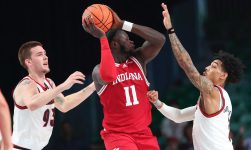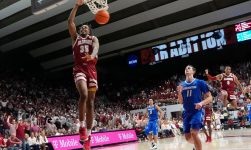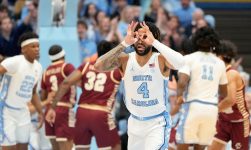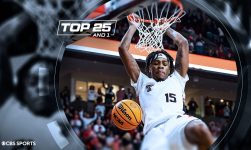CBS Sports college basketball writers Gary Parrish and Matt Norlander surveyed roughly 100 coaches for our annual Candid Coaches series. They polled everyone from head coaches at elite programs to assistants at some of the smallest Division I schools. In exchange for complete anonymity, the coaches provided unfiltered honesty about a number of topics. Over the next few weeks, we’ll be posting the results of the questions asked.
A world where student-athletes would be able to profit from their name, image and likeness (like all other students) is something some of us discussed constantly in the years leading up to it becoming a reality. Reasonable minds could disagree on the impact it would someday make on college sports, among them the sport of men’s basketball. But now, a little more than a year into this new way of doing things, it’s undeniably a big deal that has reshaped how athletic directors and coaches do their jobs. With this as the backdrop, we asked roughly 100 college basketball coaches the following question:
More than one year in, is name, image and likeness helping or hurting college athletics?
Quotes that stood out
Helping
“Probably too early to tell but I think it is helping the college basketball product. You saw some really good players return to college because of the financial implications.””We are keeping more guys in college basketball and the really good players at each program are more likely to stay at their school than transfer.””Overall NIL is helping college athletics — (but) it does need some guardrails. Even pro sports have salary caps. It has made coaching more of a challenge because there is an expectation of getting a deal at the snap of your fingers.”
“I like NIL — I just don’t think it’s been managed properly. Some of the money out there right now, I just don’t understand or see how it’s sustainable. I certainly think NIL should be an option for college athletes, it’s just gotta be managed somehow better. It’s out of control right now. I don’t understand where all this money is coming from and how it can be sustainable. It’s good for a place like my school because we would never cheat, and now it allows us to offer our players something in a legal way. It’s a good thing for college basketball, but certainly somehow needs to be managed a little better because it’s just a little bit out of control right now.”
Hurting
“It’s increased so many ways for people to move money to players, handlers and families that have nothing to do with NIL but can fall under the guise of it. Pay-for-play is more brazen than ever before.
There is no teeth in any legislation that you don’t feel the right lawyers couldn’t get you through.””Recruiting has become a silent auction for recruits going to the highest bidder. It’s not about where the best fit is anymore, style of play, role, development, etc. for a recruit’s future.””I think NIL has eliminated ‘college’ athletics, and much of this is due to the lack of progressive thought by leadership in the NCAA. They had numerous years and opportunities to find ways to allow players to profit off true NIL. Because of their backtracking, they got backed into such a corner they essentially opened the floodgates — to not players profiting of name, image and likeness, (but) legit pay-for-play. I do think the market corrects itself in the years to come. I think less people will be interested in giving money on the front side.”Overall, I think the combination of NIL and the transfer portal has hurt college athletics. I think both on their own would be fine, but when you put the two together you have poison. Mid-major farm teams. Collusion at the high-major level and free agency with no contracts. At least in the NBA there is a salary cap and contracts with penalties.”
The takeaway
After polling roughly 100 college basketball coaches, and having various conversations with them over the past year, I think the consensus is that most are cool with student-athletes earning NIL money but less than thrilled with the lack of guidelines that have turned many recruitments into nothing more than bidding wars.
And I get that.
Candid Coaches
But, truth is, NIL opportunities were always going to immediately turn into recruiting inducements that influenced where players enrolled, which is why it was silly for the NCAA to ever pretend otherwise. I remember being on the first conference call after the NCAA announced it was working on developing a system in which student-athletes would have NIL rights. When it was my turn to talk, I politely asked how the governing body planned to prevent NIL from being used in recruiting. Unsurprisingly, the people tasked with developing this system had no answer to that question because — and I knew this before I asked; I just asked to make a point — no answer to that question ever existed. It was always going to be literally impossible to develop a system — at least a system that would hold up under legal scrutiny — where NIL didn’t impact recruiting. And that’s why I don’t really understand how there were coaches out there who expected anything other than exactly what’s happening now once NIL entered college athletics.
It is, as they say, what it is.
All that said, I am empathetic to the idea that NIL rights becoming a reality, more or less at the same time that the one-time transfer also became a reality, was a real shock to the system. Suddenly, coaches who have been doing this for decades were forced to do their jobs in new, complicated and challenging ways. So I understand the frustration and why the majority of them believe NIL is currently hurting more than helping. Honestly, I do. But what I’m less understanding of is when coaches lament the fact that some recruits are picking schools mostly for financial reasons when coaches have for decades also picked schools mostly for financial reasons. Money has long dictated where coaches work — so what’s so bad about it sometimes dictating where players play? And to those who don’t like the idea of high-major programs buying accomplished and proven players off of mid-major campuses, I’d just kindly remind you that high-major programs have been buying accomplished and proven coaches off of mid-major campuses forever. If you’re OK with the latter, you should be OK with the former. Otherwise, you’re being hypocritical.
Bottom line, the regulations so many coaches want to stabilize the market and clean-up gray areas probably won’t be implemented until student-athletes are allowed to unionize and collectively bargain. Most agree, that’s where this is headed. Exactly when, who knows? But, most agree, that’s where this is headed — someday. In the meantime, the schools with the most passionate boosters and organized collectives will flourish when it comes to recruiting high school prospects and transfers. But — and this is something I always predicted would be the case — those schools are largely going to be the same schools that were flourishing pre-NIL. In other words, the idea that any of this is shaking up the order of things is simply unfounded — evidence being that blue-blood Kansas just played blue-blood North Carolina in the NCAA Tournament title game, and that blue-blood Duke just enrolled the nation’s top-ranked recruiting class.






